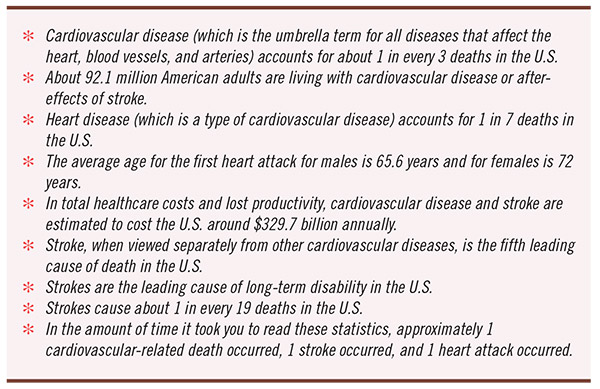
Tips for Heart Health
February is the perfect time to talk about the heart. Not the heart in the sense of love and relationships, but in the literal sense. It’s American Heart Month, the goal of which is to get people to think more about their own heart and take better care of it. With heart disease being the No. 1 cause of death in the United States, this month is more important than I can stress to you in my own words, so let’s look at some statistics from the American Heart Association and American Stroke Association about cardiovascular diseases and strokes.
Who is at risk?
People at risk for cardiovascular-related health issues include those with genetic heart defects and those with certain lifestyle habits or health factors. The American Heart Association lists seven key factors as those that influence heart-related illnesses, aside from genetics. Smoking, physical inactivity, poor nutrition/diet, obesity or being overweight, and high cholesterol, blood sugar, and blood pressure.
That said, how many of those seven are your pitfalls? Can you improve your heart health?
Ways to help lower your risks:
- Quit smoking
- Exercise daily
- Maintain proper weight
- Reduce your stress
- Eat a proper diet rich in heart-healthy foods and low in fatty, sugary foods
(These five tips are ways to control your cholesterol, blood sugar, and blood pressure, and as a result this can lower your risk of cardiovascular issues.)
Let’s talk more about one of those five points – eating a proper diet rich in heart-healthy foods. It’s known that fried, fatty, and sugary foods are bad for you, so I’ll save the lecture on that. Let’s focus instead on heart-healthy foods that you can incorporate into your diet.
There are several heart-healthy foods you can choose from that don’t spike your blood sugar or increase your LDL (bad) cholesterol. Some particularly heart-healthy ingredients to look for in foods include:
- Omega-3s – Found in fish like salmon, tuna, mackerel, herring, and more. Plant foods with high omega-3s include flax seeds, chia seeds, soy beans, walnuts, Brussels sprouts, and more.
- Fiber – Found in lentils, beans, broccoli, nuts, flax seeds, brown rice, and more.
- Lignans* – Found in seeds like flax, pumpkin, sunflower, and sesame, plus beans, berries, and a variety of vegetables.
*Researchers are still studying the potential cardiovascular benefits of lignans but have so far found some positive effects. One study followed men for an average of 12 years and found that they were significantly less likely to die from coronary heart disease or cardiovascular disease when they had a high marker of plant lignan intake versus those with low intake.
One of the foods that has all three properties – omega-3s, fiber, and one of the highest concentrations of lignans – is flax seed. Several studies have shown a modest decrease in LDL cholesterol levels in those consuming 30 to 50 grams per day of flax seeds. In conjunction with an overall healthy diet and regular exercise, incorporating flax could help to lower your cholesterol and thus lower your risk of cardiovascular diseases.
For those of you looking for an easy way to incorporate flax into your daily diet, I have a few suggestions. Buy whole flax seeds and use a spice or coffee grinder to grind some into a powder. Store the powder in the refrigerator and add a scoop or two to gluten-free oatmeal or smoothies. You can also make a flax “egg” using ground flax and water and use this in place of all or some of the eggs in many baked goods recipes. And for those wanting to replace pre-packaged gluten-free goods with healthier alternatives, I suggest Flax4Life brand muffins, granola, brownies, and cakes. These products incorporate flax and have high amounts of fiber, lignans, and omega-3s, making them a better alternative to other gluten-free baked goods.
“We knew we wanted to produce a gluten-free product and after researching and reading some of the health benefits, we decided to focus on flax,” said Sarah Bishop, marketing coordinator for Flax4Life. “Our goal was to make a gluten-free product that was also healthy.”
The company did just that. With an average of 4,000 milligrams of omega-3s, 20 to 60 milligrams of lignans, and 10 milligrams of fiber per item, you can have your favorite gluten-free treats but in heart-healthier versions.
What can you do if you already live a heart-healthy lifestyle?
It never hurts to incorporate more heart-healthy foods into your diet, like Flax4Life products. But most importantly, share this information with loved ones, especially if they are at risk for cardiovascular diseases. Heart disease should not be the No. 1 cause of death in America. We already have diseases that we cannot prevent, so let’s do something about the ones we can.
For more information about Flax4Life, visit flax4life.net
References:
Heart Disease & Stroke Statistics 2018 At-a-Glance; American Heart Association
Lignans; Micronutrient Information Center, Oregon State University Linus Pauling Institute
Written by Malory Speir





Thank You for the nice article, which gives us the proper direction that our heart needs to care more.